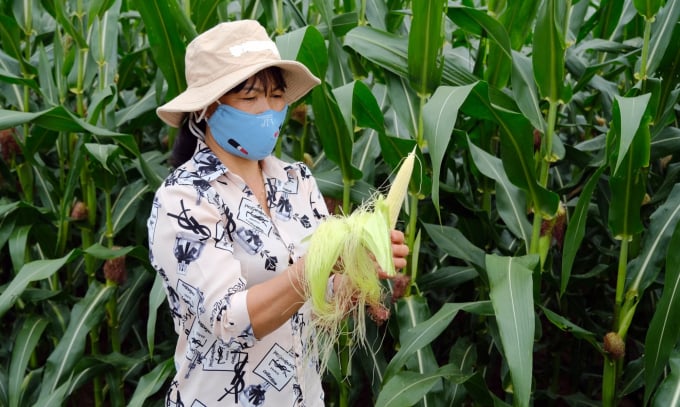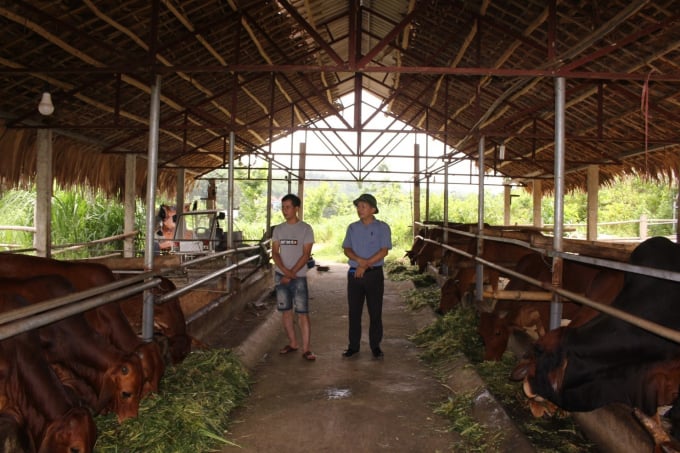May 24, 2025 | 16:25 GMT +7
May 24, 2025 | 16:25 GMT +7
Hotline: 0913.378.918
May 24, 2025 | 16:25 GMT +7
Hotline: 0913.378.918
One of the very important crops for the livestock industry is maize. But maize kernels’ domestic output can only meet 20% of the demand at the moment, while the remaining 80% must rely on imports.
Looking from an overview, Vietnam's corn yield is only nearly 5 tons/ha while the average yield worldwide is from 5.5 to 5.8 tons/ha. Especially in the USA the average yield of maize is 10.5 - 10.7 tons/ha. And in China, the country next to us, maize yield is 5.9 - 6.3 tons/ha. Thus it can be affirmed that the maize yield of Vietnam, despite increasing improvement in recent times, has not yet met the set target.
This is also the reason why the domestic grain corn product remains low in competitiveness, not only because of the low yield but also the low quality. Farmers conducting small-scale production which results in the uneven quality of corn kernels is the primary cause of the unfulfillment of the feed processing industry's demand.

Biomass maize - Vietnam's competitive advantage. Photo: Bao Thang.
But it is fair to say that domestic maize production holds certain advantages compared to imported products, that is, in addition to corn kernels farmers can harvest by-products such as stems, leaves, and cobs. These by-products have a relatively high nutritional content and can be used as animal feeds.
The only problem is that farmers mainly choose to leave the stems and leaves in the field, and then plow them to make fertilizer with the intention of adding nutrients to the soil instead of using these by-products as animal feeds. As for the cob, despite having collected it after separating the kernels, people mainly use it for fuel, because of that, the price is very high and the market is always short of supply.
In general, with high production costs and limited domestic production capacity, it is certain that corn imported to Vietnam from abroad at a cheaper price and with more uniform quality will prevail as input material for industrial feed production. But with our current scale of household production, we can still further develop the corn growing area if we take full advantage of the corn from stems, leaves, cobs to seeds, especially when the winter crop in the northern provinces still commonly has the situation of many fields left empty.
As for soybean, the output is still very small. This plant is mainly grown in the Red River Delta, North Central and Central Highlands provinces, with yield so far only reaching 1.5-2 tons/ha.
Soybean growing is also being tested in the Mekong Delta and shows good potential if we restructure the crops to develop the 1 soybean - 2 rice intercropping model. Dong Thap and An Giang are currently deploying in this direction, and if mechanization becomes possible, the advantage of growing soybeans in the Mekong Delta will certainly be promoted, helping farmers take a step further in terms of production efficiency.
Some domestic enterprises are actively developing soybean areas such as Vinamilk and TH True Milk. Vietnam's soybean variety is not genetically modified, so it is aromatic and thus suitable for processing soy milk. As for soybean by-products, including stems and leaves, people mainly leave it in the field as fertilizer because of its very high nitrogen content which helps regenerate soil health.

Many livestock households convert inefficient rice land to growing Napier grass to expand the scale of cattle raising.
And so, with the production conditions of the Northern provinces, the short growing period of soybean is very suitable for planting in the winter crop, thereby meeting a part of the soybean output for animal husbandry and food processing.
In addition to corn and soybean, the Vietnam Academy of Agricultural Sciences (VAAS) has also studied wheat and barley in recent times. However, since its pilot implementation in 2006 there has been almost no research on it. The VAAS is only storing genes at the moment. If wheat and barley crops are produced in the northern provinces during the winter, another part of the demand for animal feed can be secured.
The VAAS also has a unit specializing in research on plant and grass for animal husbandry and has achieved certain achievements. There is a grass variety rich in crude protein and has been experimentally planted in some arid regions in the Central provinces. In a similar manner, green Napier grass is also being studied for further development.
Cassava is quite a potential crop. Its total annual planting area is about 500,000 ha, but the average yield of cassava in Vietnam is only 20 tons/ha at present. We can completely increase the overall cassava yield to 25-30 tons/ha since in Tay Ninh cassava yield has been able to reach 40 tons/ha. One thing to note is that in order for cassava to become an input material for animal husbandry, we need to study product processing recipes.
We can also grow sweet potatoes for animal feed. The total area of sweet potato is approximately 11,000 ha at present with an output of nearly 1.3 million tons of tubers and a by-product output of 1.3 million tons (stems and leaves) per year.
“A very important issue is that we have to research and apply appropriate processing and preservation technologies so that we can use the food for a longer time while maintaining the nutritional content suitable for each production scale (households, farms, cooperatives, or large enterprises). We are still weak in this stage, thus explaining why our country has to import a very large amount of green food and dry silage from foreign countries every year,” said Mr. Nguyen Nhu Cuong, Director of the Department of Crop Production.
Translated by Samuel Pham

(VAN) The People's Committee of Tra Vinh province has approved an adjustment to the investment policy for the Green Hydrogen Plant project, increasing its area to approximately 52.76 hectares.
![Reducing emissions from rice fields: [2] Farmers’ commitment to the soil](https://t.ex-cdn.com/nongnghiepmoitruong.vn/608w/files/news/2025/05/05/dsc08881jpg-nongnghiep-140632.jpg)
(VAN) Clean rice cultivation model in Thuong Tan commune, Bac Tan Uyen district, is assisting local residents in achieving sustainable agriculture by substantially reducing costs, increasing productivity, and protecting the environment.

(VAN) At the conference to disseminate Resolution No. 68, AgriS introduced its digital agricultural ecosystem and reaffirmed its commitment to accompanying the Government in promoting private sector development and sustainable agriculture.

(VAN) 'Blue Ocean - Blue Foods' initiative is designed to restore marine ecosystems and establish sustainable livelihoods for local communities by cultivating a minimum of 1,000 hectares of cottonii seaweed in the first three years.
/2025/05/21/4642-3-112707_603.jpg)
(VAN) The V-SCOPE project has made direct contributions to three out of six pillars of the Comprehensive Strategic Partnership between Vietnam and Australia.

(VAN) Facing the threat of rabies spreading to the community, Gia Lai province urgently carries out measures to vaccinate dogs and cats on a large scale.

(VAN) Disease-free livestock farming not only protects livestock herds but also stabilizes production and livelihoods for many farmers in Tuyen Quang.